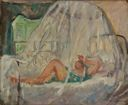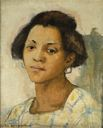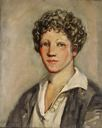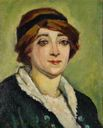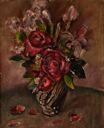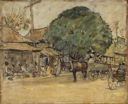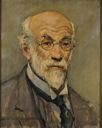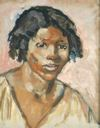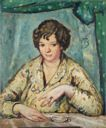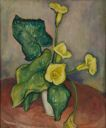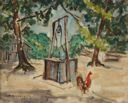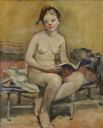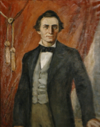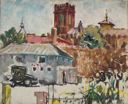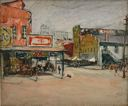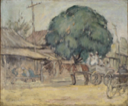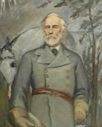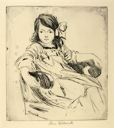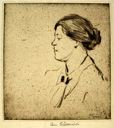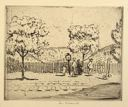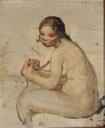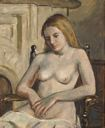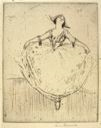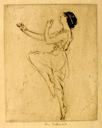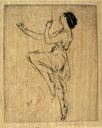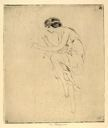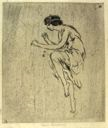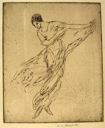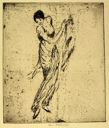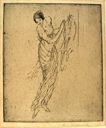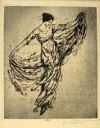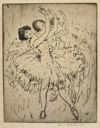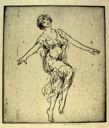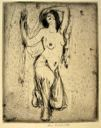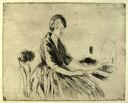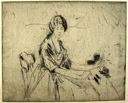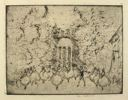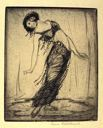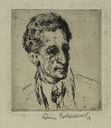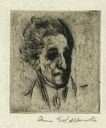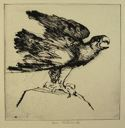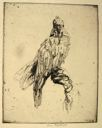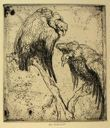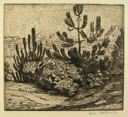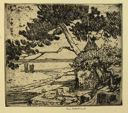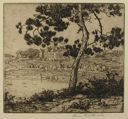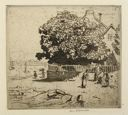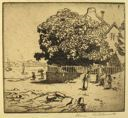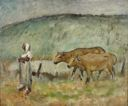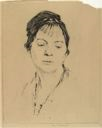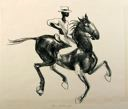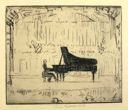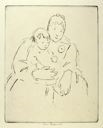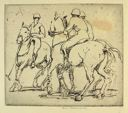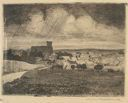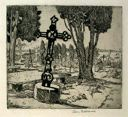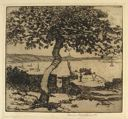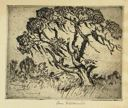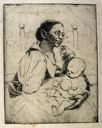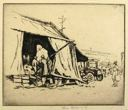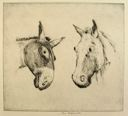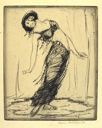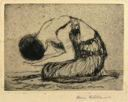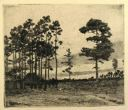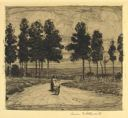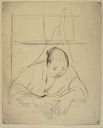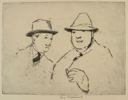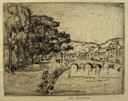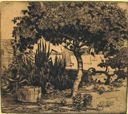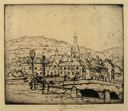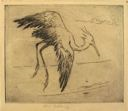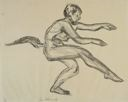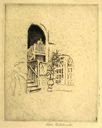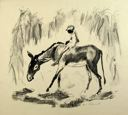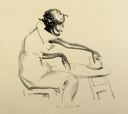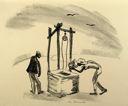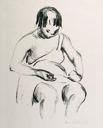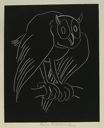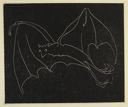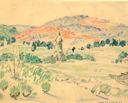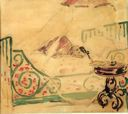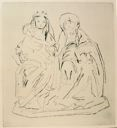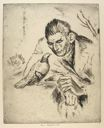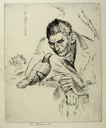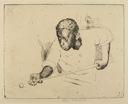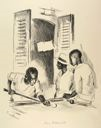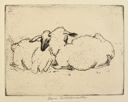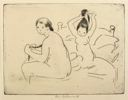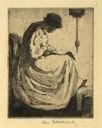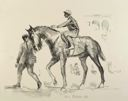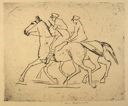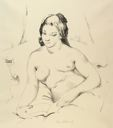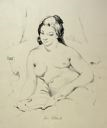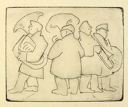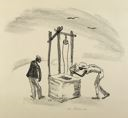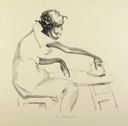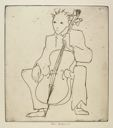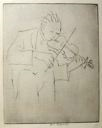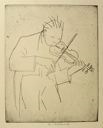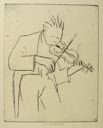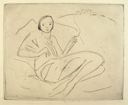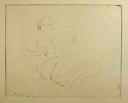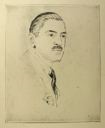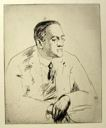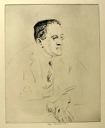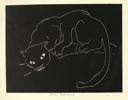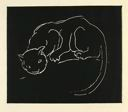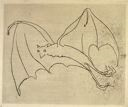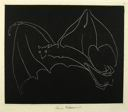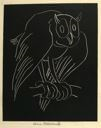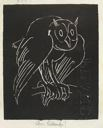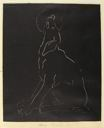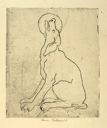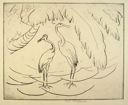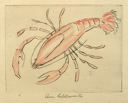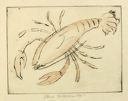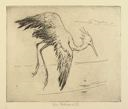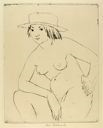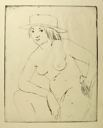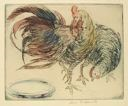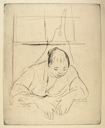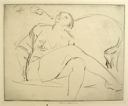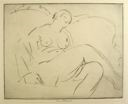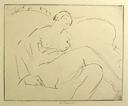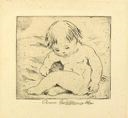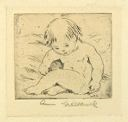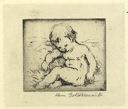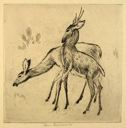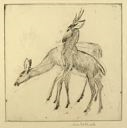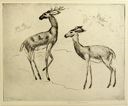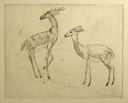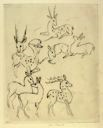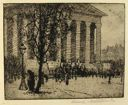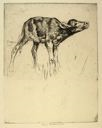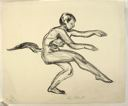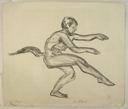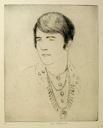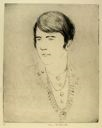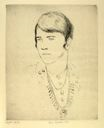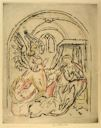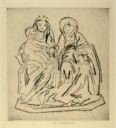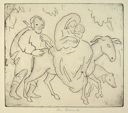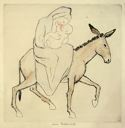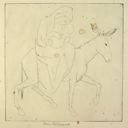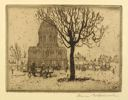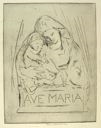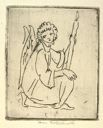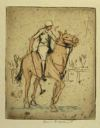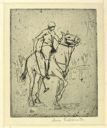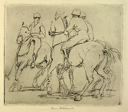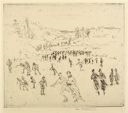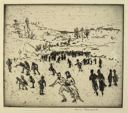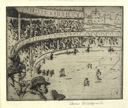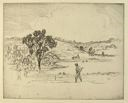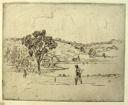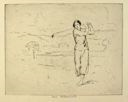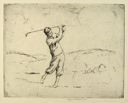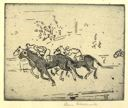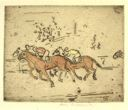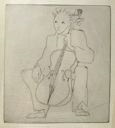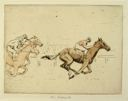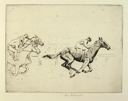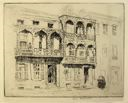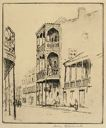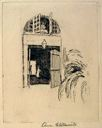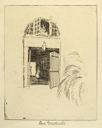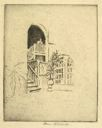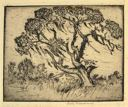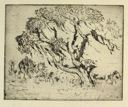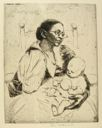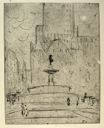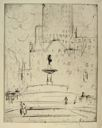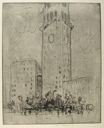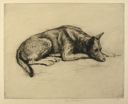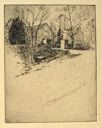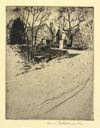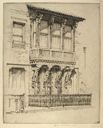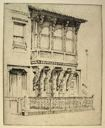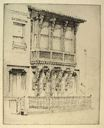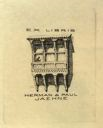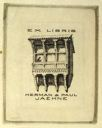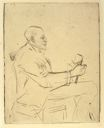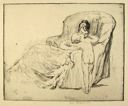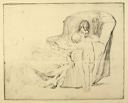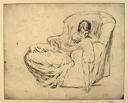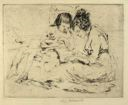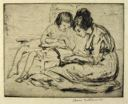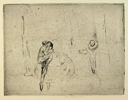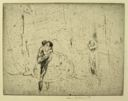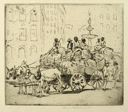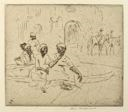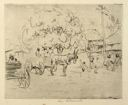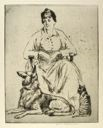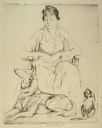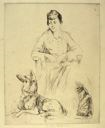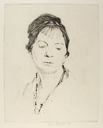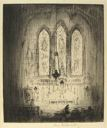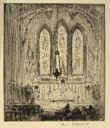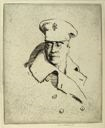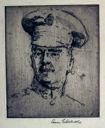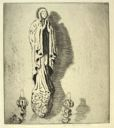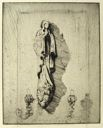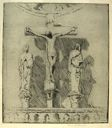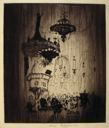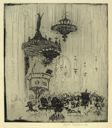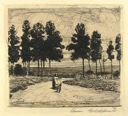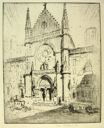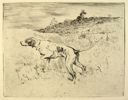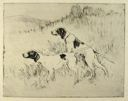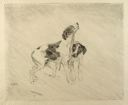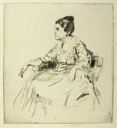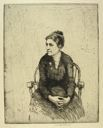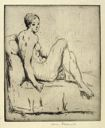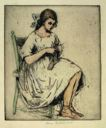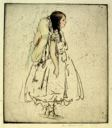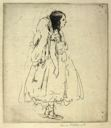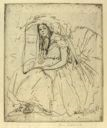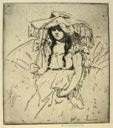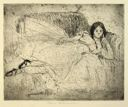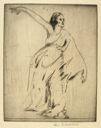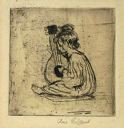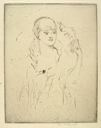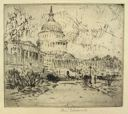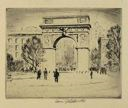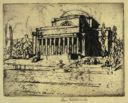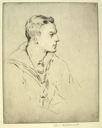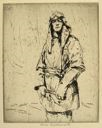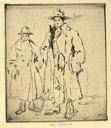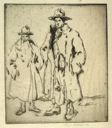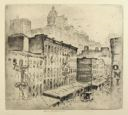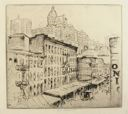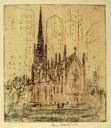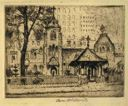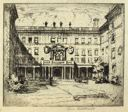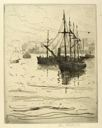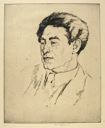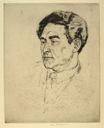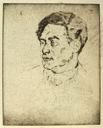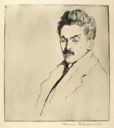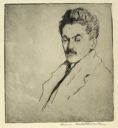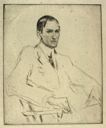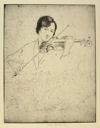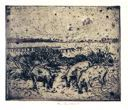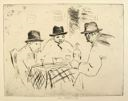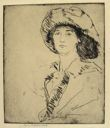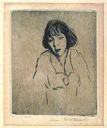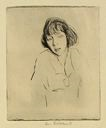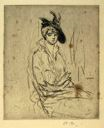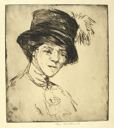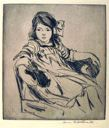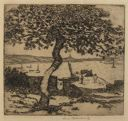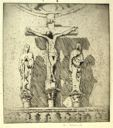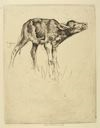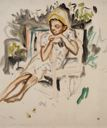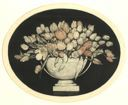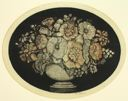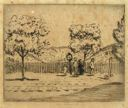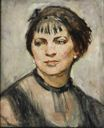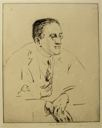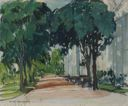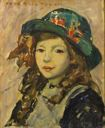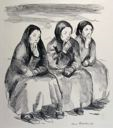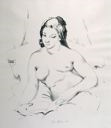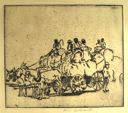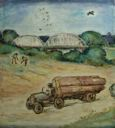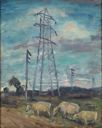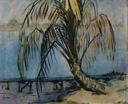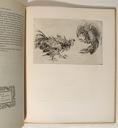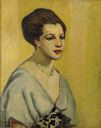Anne Goldthwaite
American
(Montgomery, Alabama, 1869 - 1944, New York, New York)
Anne Goldthwaite’s artistic talents were a source of pride, and no doubt some relief, to her Montgomery, Alabama, family. The high-spirited young woman bridled at the usual invitations to country club dances and the endless search for eligible beaus. With a perversity that in fact may not have been so unusual in Southern girls, she insisted on wandering the town alone, pad and pencil always at hand for sketching. Despite this early preparation, Goldthwaite was not optimistic about her chances for success when she arrived in New York at the turn of the twentieth century to train as a professional artist. She surmised that the talents so gratifying to a solicitous family might “seem very thin in New York,” and in truth she had ample reason for skepticism. In that era, women typically undertook artistic activity only casually, and young ladies from Montgomery could expect little support for any professional endeavor. (1)
“The early years of my life,” Goldthwaite wrote in 1939, “were the golden age…filled with love and warmth and ease and approbation.” (2) Goldthwaite’s memoirs—begun late in her life and never completed—suggest the character of their author, evoking a perceptive, witty, contemplative, and, above all, romantic woman who treasured the identity that her Southern heritage imparted to her art and life. The daughter of Richard Wallach Goldthwaite (1838-1881), a Confederate artillery officer who was also an attorney, and a “belle” named Lucy Boyd Armistead (1849-1884). Anne was born in Montgomery and then moved with her parents to Texas in 1873, where she enjoyed what seemed to her an idyllic existence in the remote outpost of Dallas. Anne’s father died in 1881. She and her younger siblings were orphaned after her mother’s death when Anne was 14 years old, and they returned to Montgomery to live with family members in 1884. Anne found a comfortable home with her aunt Molly Arrington, who matter-of-factly accepted her unorthodox, serious commitment to art. Aunt Molly, whose devotion was apparently exceeded only by her pragmatism, determined that Anne must follow her heart’s desire and study art with an eye toward a professional career. (3)
She went to New York around 1894 to study art. She was initially supported in this endeavor by her uncle, Henry Goldthwaite, who was her father’s brother. Her uncle Henry lived and worked in New York and held a seat on the Cotton Exchange as a cotton broker. (4) He offered to support her for “eight or ten years,” acknowledging the uphill battle she would face as a woman seeking recognition in the art world at that time. Goldthwaite enrolled at the National Academy of Design and also sought instruction in the techniques of commercial etching, a practical skill from which she profited in later years. (5)
In 1906, Goldthwaite, like countless other Americans before her, went to Paris with the intention of studying art and gaining experience. As a young woman of good family, however, she kept firmly to established paths. Her memoirs provide glimpses into her life as a young lady art student, which was in sharp contrast to the better-known bohemianism that prevailed in other circles. She was introduced to Gertrude Stein and invited to tea to see the Stein’s French Modernist collection, but she resided at a pension for American ladies, Mrs. Whitelaw Reid's Club for American Girls at 4 Rue de Chevreuse, and flourished in its comfortable, genteel atmosphere. In effect, she enjoyed both worlds. “Though our lives were somewhat exemplary,” she wrote, “we knew all that went on around us.” (6)
What “went on around” her did have a lasting influence on her art. Her paintings demonstrate a successful synthesis of academic training and Post-Impressionist innovations. Stylistically, Goldthwaite emphasized the linear qualities of her subjects, an approach that served her particularly well when she sought to record images of her Southern home during the 1920s and 1930s. In Alabama, the hot, bright summer sun obscures details and silhouettes the contours of forms; Goldthwaite’s summary, spontaneous application of paint preserves this brilliant luminosity.
In 1913 Goldthwaite settled in New York, where she resided for the rest of her life. Portrait commissions became a staple of her artistic output. She also produced a large number of etchings and lithographs, whose sales augmented her income. She exhibited regularly at the Downtown Gallery and at the Berlin Photographic Gallery, and in 1915 she won the McMillan landscape prize at the National Association of Women Painters and Sculptors annual show. From 1921 onward, Goldthwaite taught at the Art Students League, and during the Great Depression, the Works Projects Administration commissioned her to paint murals for two Alabama post offices, in Atmore and Tuskegee.
Nevertheless, family ties routinely brought her back to Alabama, and because she exhibited work with distinctively Southern subjects, she became known in New York as “the leading painter of the South.” Art Historian Adelyn Breeskin in a 1977 exhibition catalogue of the artist’s work reflected on the skill with which the artist was able to capture the ‘feeling’ of the South. “In all of her work she achieved that rare quality called style and regardless of the years away from her native Alabama she evoked the spirit of the South.” (7)
(1) Portions of this text are excerpted from Margaret Lynne Ausfeld, “Anne Goldthwaite (1886–1944),” in Eight Southern Women (Greenville, SC: Greenville County Museum of Art, 1986), pp. 12–14.
(2) The memoirs were edited and annotated by Adelyn Breeskin in "Anne Goldthwaite: A Catalogue Raisonné of the Graphic Work" (Montgomery: The Montgomery Museum of Fine Arts, 1982), p. 13.
(3) Anne had three younger siblings—Herbert (born 1872), Olivia (born 1875), and Lucille (born 1878). It is unclear in the memoirs where her brother and sisters were housed after they all returned to Alabama from Dallas after the death of their mother in 1884. Anne discusses only her own life with the family of her aunt Molly Arrington, who was her father’s sister. Ibid, p.19.
(4) Adelyn Breeskin, "Anne Goldthwaite: A Catalogue Raisonné of the Graphic Work" (Montgomery: The Montgomery Museum of Fine Arts, 1982), p. 20.
(5) Goldthwaite produced over 320 prints; see ibid.
(6) Breeskin, p. 25.
(7) "Anne Goldthwaite, 1869-1944," Introduction by Adelyn Breeskin (Montgomery: The Montgomery Museum of Fine Arts, 1977), p. 15.
Text partially excerpted from American Paintings from the Montgomery Museum of Fine Arts, 2006, cat. nos. 47 and 48, pp. 126-129.
American
(Montgomery, Alabama, 1869 - 1944, New York, New York)
Anne Goldthwaite’s artistic talents were a source of pride, and no doubt some relief, to her Montgomery, Alabama, family. The high-spirited young woman bridled at the usual invitations to country club dances and the endless search for eligible beaus. With a perversity that in fact may not have been so unusual in Southern girls, she insisted on wandering the town alone, pad and pencil always at hand for sketching. Despite this early preparation, Goldthwaite was not optimistic about her chances for success when she arrived in New York at the turn of the twentieth century to train as a professional artist. She surmised that the talents so gratifying to a solicitous family might “seem very thin in New York,” and in truth she had ample reason for skepticism. In that era, women typically undertook artistic activity only casually, and young ladies from Montgomery could expect little support for any professional endeavor. (1)
“The early years of my life,” Goldthwaite wrote in 1939, “were the golden age…filled with love and warmth and ease and approbation.” (2) Goldthwaite’s memoirs—begun late in her life and never completed—suggest the character of their author, evoking a perceptive, witty, contemplative, and, above all, romantic woman who treasured the identity that her Southern heritage imparted to her art and life. The daughter of Richard Wallach Goldthwaite (1838-1881), a Confederate artillery officer who was also an attorney, and a “belle” named Lucy Boyd Armistead (1849-1884). Anne was born in Montgomery and then moved with her parents to Texas in 1873, where she enjoyed what seemed to her an idyllic existence in the remote outpost of Dallas. Anne’s father died in 1881. She and her younger siblings were orphaned after her mother’s death when Anne was 14 years old, and they returned to Montgomery to live with family members in 1884. Anne found a comfortable home with her aunt Molly Arrington, who matter-of-factly accepted her unorthodox, serious commitment to art. Aunt Molly, whose devotion was apparently exceeded only by her pragmatism, determined that Anne must follow her heart’s desire and study art with an eye toward a professional career. (3)
She went to New York around 1894 to study art. She was initially supported in this endeavor by her uncle, Henry Goldthwaite, who was her father’s brother. Her uncle Henry lived and worked in New York and held a seat on the Cotton Exchange as a cotton broker. (4) He offered to support her for “eight or ten years,” acknowledging the uphill battle she would face as a woman seeking recognition in the art world at that time. Goldthwaite enrolled at the National Academy of Design and also sought instruction in the techniques of commercial etching, a practical skill from which she profited in later years. (5)
In 1906, Goldthwaite, like countless other Americans before her, went to Paris with the intention of studying art and gaining experience. As a young woman of good family, however, she kept firmly to established paths. Her memoirs provide glimpses into her life as a young lady art student, which was in sharp contrast to the better-known bohemianism that prevailed in other circles. She was introduced to Gertrude Stein and invited to tea to see the Stein’s French Modernist collection, but she resided at a pension for American ladies, Mrs. Whitelaw Reid's Club for American Girls at 4 Rue de Chevreuse, and flourished in its comfortable, genteel atmosphere. In effect, she enjoyed both worlds. “Though our lives were somewhat exemplary,” she wrote, “we knew all that went on around us.” (6)
What “went on around” her did have a lasting influence on her art. Her paintings demonstrate a successful synthesis of academic training and Post-Impressionist innovations. Stylistically, Goldthwaite emphasized the linear qualities of her subjects, an approach that served her particularly well when she sought to record images of her Southern home during the 1920s and 1930s. In Alabama, the hot, bright summer sun obscures details and silhouettes the contours of forms; Goldthwaite’s summary, spontaneous application of paint preserves this brilliant luminosity.
In 1913 Goldthwaite settled in New York, where she resided for the rest of her life. Portrait commissions became a staple of her artistic output. She also produced a large number of etchings and lithographs, whose sales augmented her income. She exhibited regularly at the Downtown Gallery and at the Berlin Photographic Gallery, and in 1915 she won the McMillan landscape prize at the National Association of Women Painters and Sculptors annual show. From 1921 onward, Goldthwaite taught at the Art Students League, and during the Great Depression, the Works Projects Administration commissioned her to paint murals for two Alabama post offices, in Atmore and Tuskegee.
Nevertheless, family ties routinely brought her back to Alabama, and because she exhibited work with distinctively Southern subjects, she became known in New York as “the leading painter of the South.” Art Historian Adelyn Breeskin in a 1977 exhibition catalogue of the artist’s work reflected on the skill with which the artist was able to capture the ‘feeling’ of the South. “In all of her work she achieved that rare quality called style and regardless of the years away from her native Alabama she evoked the spirit of the South.” (7)
(1) Portions of this text are excerpted from Margaret Lynne Ausfeld, “Anne Goldthwaite (1886–1944),” in Eight Southern Women (Greenville, SC: Greenville County Museum of Art, 1986), pp. 12–14.
(2) The memoirs were edited and annotated by Adelyn Breeskin in "Anne Goldthwaite: A Catalogue Raisonné of the Graphic Work" (Montgomery: The Montgomery Museum of Fine Arts, 1982), p. 13.
(3) Anne had three younger siblings—Herbert (born 1872), Olivia (born 1875), and Lucille (born 1878). It is unclear in the memoirs where her brother and sisters were housed after they all returned to Alabama from Dallas after the death of their mother in 1884. Anne discusses only her own life with the family of her aunt Molly Arrington, who was her father’s sister. Ibid, p.19.
(4) Adelyn Breeskin, "Anne Goldthwaite: A Catalogue Raisonné of the Graphic Work" (Montgomery: The Montgomery Museum of Fine Arts, 1982), p. 20.
(5) Goldthwaite produced over 320 prints; see ibid.
(6) Breeskin, p. 25.
(7) "Anne Goldthwaite, 1869-1944," Introduction by Adelyn Breeskin (Montgomery: The Montgomery Museum of Fine Arts, 1977), p. 15.
Text partially excerpted from American Paintings from the Montgomery Museum of Fine Arts, 2006, cat. nos. 47 and 48, pp. 126-129.
Artist Objects
